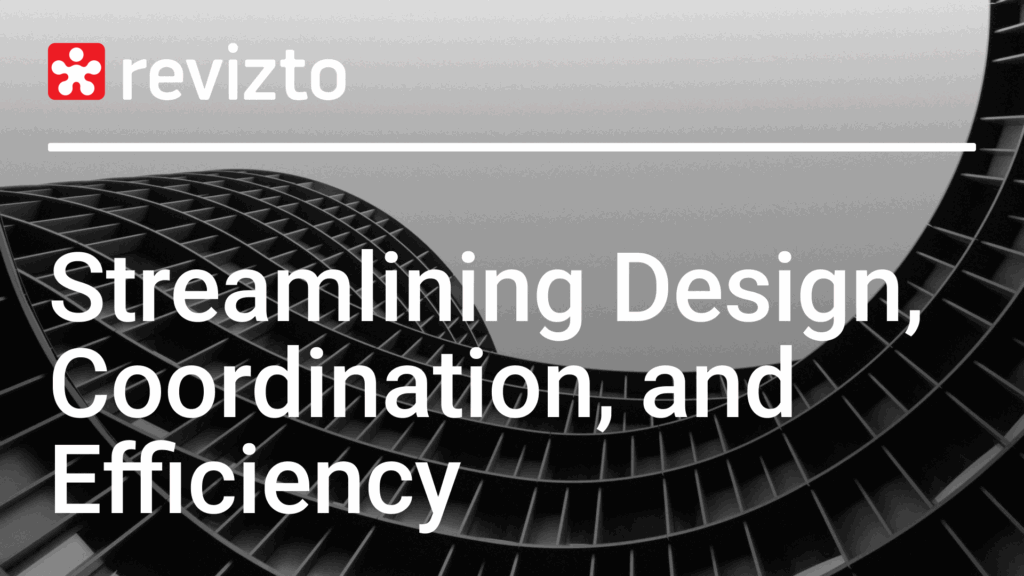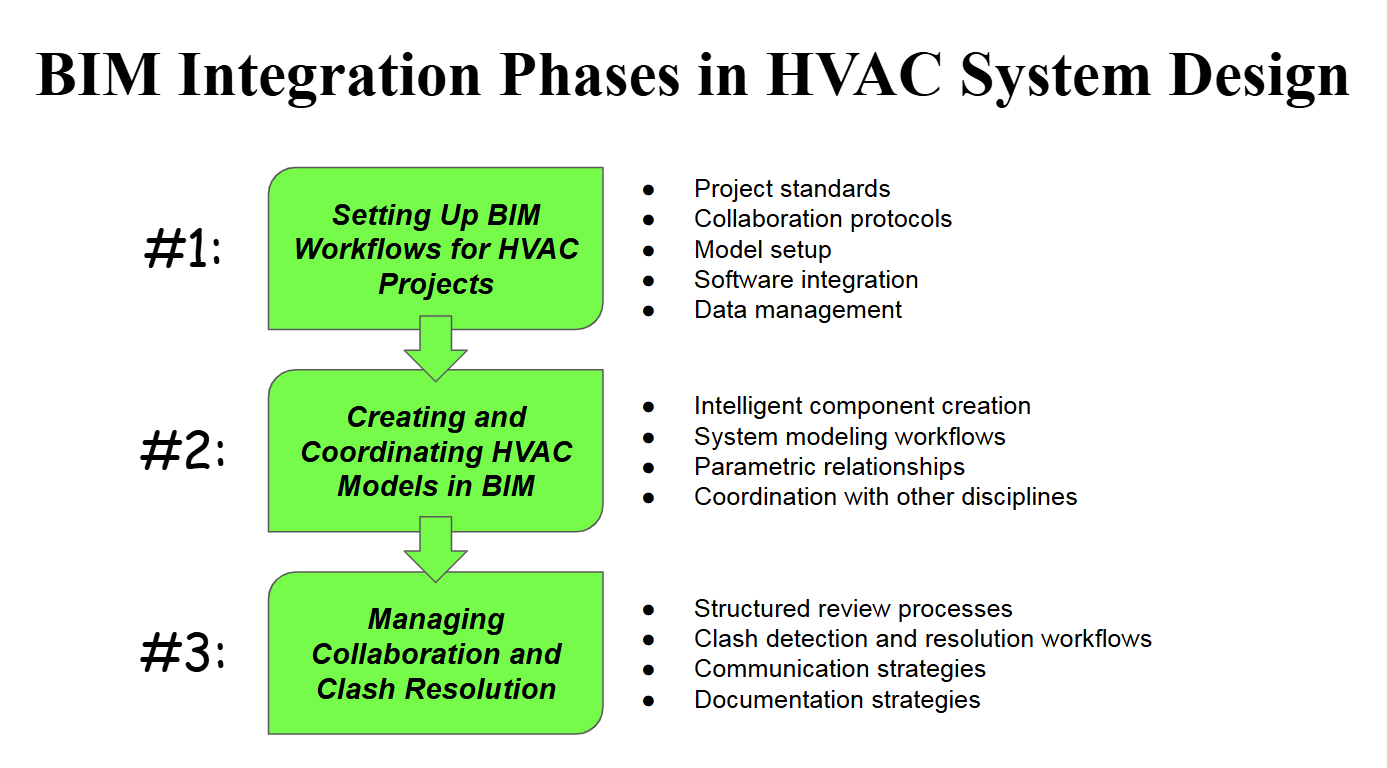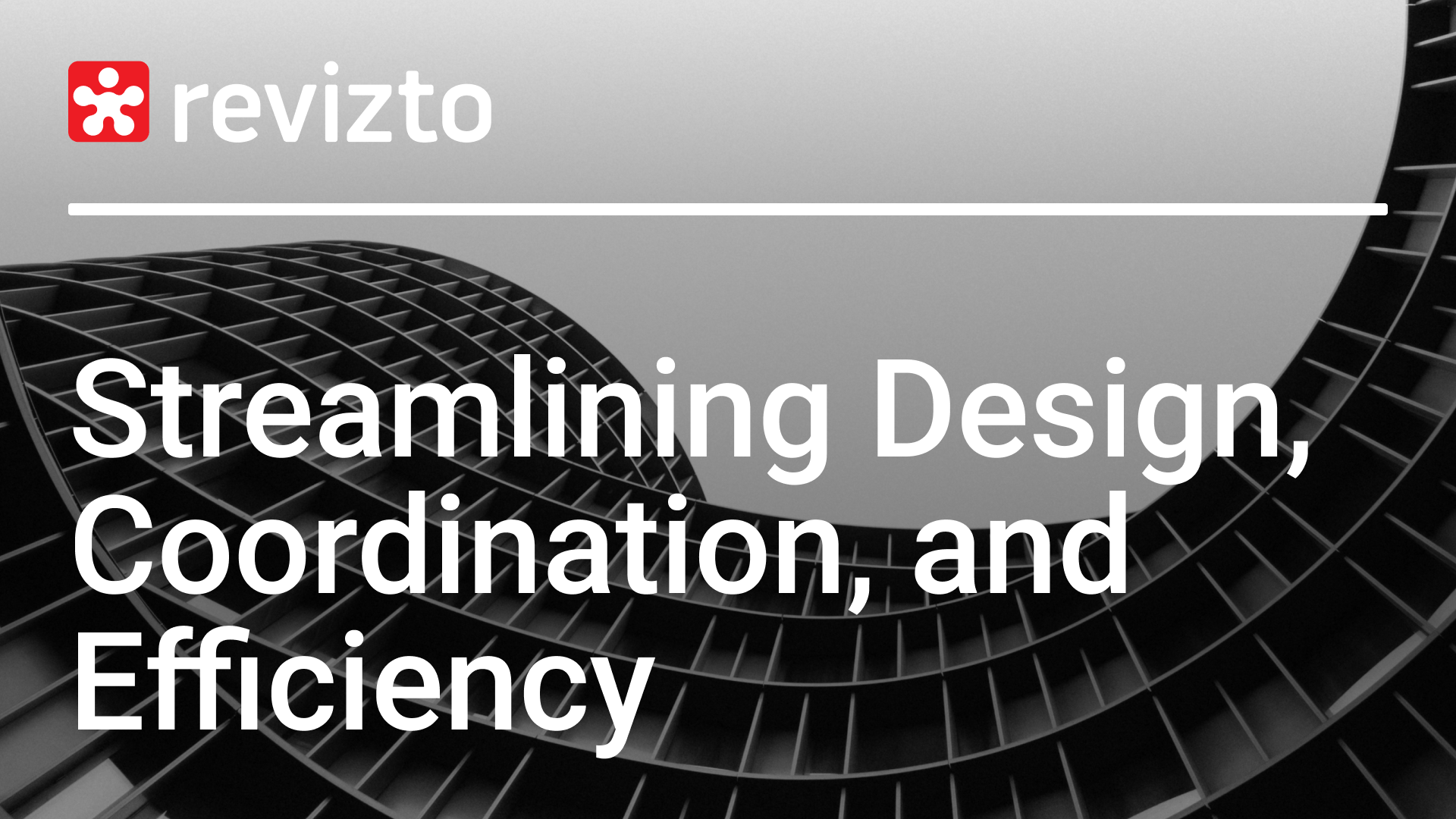BIM for HVAC: streamlining design, coordination, and efficiency
- Understanding HVAC systems and their importance
- What is BIM and how does it relate to HVAC design?
- Integrating BIM in HVAC system design: step-by-step guide
- Best practices for optimizing HVAC system design
- Future of HVAC BIM: technologies, trends, and professional preparation
- Key takeaways
- Frequently asked questions

Understanding HVAC systems and their importance
HVAC (Heating, Ventilation, and Air Conditioning) systems are essential to modern buildings, operating with substantial design complexity that has the potential to create significant challenges for construction experts. Covering the fundamentals of HVAC systems, the reasons for their ongoing improvement, and the most persistent issues in traditional design workflows is important for achieving a better understanding of how HVAC environments operate.
What are HVAC systems and how do they function?
HVAC is a combination of three interconnected systems responsible for regulating indoor climate conditions in buildings. The primary responsibilities of each system are:
- Heating (H) systems generate and distribute warmth using boilers, furnaces, and heat pumps.
- Ventilation (V) systems are tasked with circulating fresh air while removing stale indoor air with the help of fans and filtration systems.
- Air conditioning (AC) systems work on reducing heat and humidity by using a combination of distribution networks and refrigeration cycles
These three components, when put together, create a complex integrated network that requires precise engineering coordination for effective energy consumption management while maintaining an optimal indoor environment.
Why is optimizing HVAC design crucial for building efficiency?
HVAC systems account for a sizable portion of a building’s total energy consumption in most cases, meaning that optimization is essential for both sustainability and control over total costs. Poor design choices in HVAC have a direct impact on operational expenses, with correct sizing, advanced controls, and efficient equipment selection being a few of many examples of how these systems can be optimized in terms of energy consumption.
Occupant comfort and productivity depend heavily on HVAC performance. There have been multiple peer-reviewed studies, including Harvard’s CogFX study across six countries, showing that optimal temperature and air quality has a measurable positive impact on worker productivity (around 6-9%). On the other hand, poorly designed systems have a negative impact on satisfaction and health due to their ability to create uncomfortable conditions. Well-designed HVAC systems also reduce maintenance costs, prevent issues with moisture, and extend building lifespan with proper environmental conditions, protecting building materials and structural integrity.
What are the common challenges in CAD-based HVAC design workflows?
Traditional CAD-based (Computer-Aided Design) design workflows create persistent obstacles that impact project success and collaboration effectiveness in the construction industry. There are three main groups of challenges that CAD-based HVAC design suffers from:
- Coordination issues
- Clash detection issues
- Limitations of design iteration
Coordination difficulties
Coordination challenges are the biggest issue with HVAC systems, since they have to be integrated with architectural, structural, electrical, and plumbing components within the same building space. Traditional 2D drawings make it extremely difficult to visualize these complex interactions, creating conflicts that are rarely discovered until construction begins, resulting in expensive delays and change orders.
Clash detection problems
Clash detection issues happen because CAD systems are incapable of automatically identifying conflicts between HVAC and other components. Issues tend to surface during construction rather than design, such as when ductwork intersects with structural beams, piping systems interfere with electrical systems, or equipment blocks architectural features. These conflicts create their fair share of field modifications and schedule disruptions.
Design iteration limitations
Design iteration limitations can delay projects when building modifications require manual updates across every single HVAC drawing. Architectural changes or structural adjustments necessitate the complete redesign of the system, forming bottlenecks which can delay project completion while increasing design costs due to massive coordination requirements and repetitive manual work.
What is BIM and how does it relate to HVAC design?
Building information modeling (BIM) has changed the way construction professionals deal with HVAC design challenges. Knowledge of its fundamentals helps workers get the most out of new systems and solutions, while understanding the nuances of its specific applications in HVAC workflows opens up many opportunities for infrastructure optimization.
What does BIM stand for and what are its key components?
Building information modeling is a digital design methodology used to create intelligent 3D models that include comprehensive building data throughout the entirety of a project’s lifecycle. BIM models integrate geometric information with technical specifications, cost estimates, scheduling information, and operational parameters in a collaborative digital environment. This approach alone differs from traditional CAD drawings, which rarely have any information attached to them outside of geometrical data.
There are several fundamental elements of BIM that have to be covered in more detail, such as:
- 3D modeling capabilities are the foundation of BIM. They allow designers to create detailed visuals of building environments in three dimensions using precise spatial relationships.
- Data integration capabilities assist in connecting each model element to relevant information, such as performance characteristics, specifications, or maintenance requirements.
- Collaboration tools allow multiple disciplines to use BIM to work simultaneously within shared models, taking advantage of useful features like version control and real-time updates.
- Analysis and simulation features enhance the performance of structural calculations, energy modeling, and system performance optimization efforts within the same environment.
The differences between the CAD and BIM approaches are vast and varied, including, but not limited to, the following:
| Feature | CAD approach | BIM approach | Key benefits |
| Clash detection | Manual review during construction | Automated detection in design | Lower number of field conflicts |
| Collaboration | File sharing and markups | Real-time shared models | Instant coordination |
| Design changes | Manual updates across drawings | Automatic propagation | Faster design iterations |
How does BIM enhance the HVAC design process?
BIM transforms HVAC design by replacing traditional fragmented 2D workflows with integrated 3D modeling environments, which improves coordination, accuracy, and the efficiency of the project realization process throughout all of its phases.
Automated clash detection capabilities are used to identify conflicts between HVAC components and other building systems early on. This capability alone dramatically reduces or eliminates the coordination issues that have been a serious problem for traditional CAD workflows for decades.
In these traditional workflows, spatial conflicts were usually discovered only at the point where they were impossible to resolve without expensive field modifications. BIM platforms operate differently, with their ability to automatically flag intersections between ductwork and structural elements, as well as equipment placement issues, conflicts between piping and electrical systems, and so on.
Parametric modeling supports rapid design iterations when building modifications are made. For example, changes made to architectural layouts or structural systems are propagated automatically through connected HVAC components, reducing manual redesign time and maintaining system integrity.
The enhanced visualization of BIM also plays its part in assisting HVAC design processes, helping stakeholders gain a better understanding of complex installations via detailed system animations, 3D views, and virtual walkthroughs.
What are the advantages of using dedicated clash detection solutions for HVAC modeling?
Dedicated conflict identification platforms offer specialized capabilities beyond standard BIM tools, including collaborative review processes, advanced conflict identification, and resolution workflows.
Advanced detection algorithms look for subtle conflicts that basic BIM clash detection may miss, such as access requirements, clearance violations, and maintenance space conflicts. These platforms have the power to analyze both physical intersections and other factors related specifically to the installation or performance of HVAC systems, such as code compliance issues, constructability concerns, or operational clearances.
Collaborative review workflows improve conflict resolution by making it possible for distributed teams to review, prioritize, and assign clash detection resolutions using centralized platforms. Team members have the ability to add comments, attach reference documents, and track the status of resolution processes in real-time. This makes it possible to eliminate the communication gaps that are common for traditional coordination meetings.
Revizto is a great showcase of these advantages with its cloud-based clash detection platform, which was designed for construction coordination from the beginning. It integrates seamlessly with a range of major BIM platforms such as Revit and Archicad, while offering its own real-time collaboration tools, keeping stakeholders synchronized throughout the duration of the design process.
Project teams use Revizto to conduct virtual coordination meetings, resolving conflicts in an efficient manner and maintaining comprehensive audit trails of every single design decision. The use of a dedicated clash detection platform like Revizto improves overall project quality while dramatically reducing total coordination time.
Integrating BIM in HVAC system design: step-by-step guide
Transitioning from legacy CAD workflows to modern BIM-based HVAC design methods is a complex process that requires a structured approach to implementation. It has to be able to address topics like technology adoption, workflow changes, and team coordination, among others. The success of the implementation efforts hinges on being able to establish clear processes that use the collaborative capabilities of BIM without disrupting established project timelines and design quality standards.
There are three primary phases of the integration of BIM into HVAC system design:
- Setting up BIM workflows for HVAC projects
- Creating and coordinating HVAC models in BIM
- Managing collaboration and clash resolution

Step 1: Setting up BIM workflows for HVAC projects
Standard definition for HVAC projects
The process of establishing effective BIM workflows begins with defining project standards and collaboration protocols. This is done before any modeling work. Project teams must reach an agreement when it comes to file naming conventions, model organization structures, and even coordination schedules. These parameters are essential, since they serve as the governance framework for the design process in subsequent steps.
Model configuration and coordination for HVAC projects
Model setup and coordination is all about creating a shared project environment where architectural, structural, and MEP (Mechanical, Electrical, Plumbing) models are seamlessly integrated. The environment should define level and grid references, establish a common coordinate system, and set up shared parameters to ensure consistency across all building environments. Clear responsibility matrices are also included here, assisting teams with understanding which user owns which model elements and when updates occur.
Software integration and data management in HVAC projects
Both file management and software integration efforts require pre-established connections between BIM authoring tools and coordination platforms. Reliable workflows are necessary for team members to be able to share models, track changes, and conduct version control processes in order to prevent potential conflicts. Regular model synchronization schedules help prevent coordination gaps in the process. Gaps tend to create design errors if left unchecked.
Step 2: Creating and coordinating HVAC models in BIM
The development of HVAC models in BIM environments emphasizes intelligent component creation beyond simple geometric presentation. Every component of the system needs to carry a wealth of embedded information, such as installation requirements, operational parameters, and performance specifications. These parameters are essential for conducting downstream analysis and documentation workflows with an unprecedented level of accuracy.
System modeling workflows in BIM with HVAC
System modeling workflows begin with space conditioning requirements, progressing through equipment selection, control integration, and routing for distribution systems. The process always begins with thermal load analysis in order to determine the heating and cooling requirements for each space. What follows is the equipment sizing process, which is based on capacity needs and efficiency targets.
Once the previous steps have been completed, distribution systems can design and route ductwork, piping, and electrical connections with all the architectural constraints and accessibility requirements in mind. This sequential approach helps each design decision to build logically on top of the previous work, maintaining system performance objectives in the process.
Parametric relationships between BIM components
The parametric relationships between BIM components are the foundation for intelligent design environments, with changes easily propagating through connected systems. A dynamic linking process helps prevent inconsistencies, which are common in traditional design workflows where manual updates across multiple drawings inevitably cause errors or issues. Parametric modeling is also great for rapid design iterations when it comes to building modifications, maintaining system integrity and speeding up redesign processes at the same time.
BIM coordination with different disciplines
Coordination with other disciplines becomes systematic with clash detection cycles and regular model federation. HVAC systems have to be integrated with architectural features, structural framing, electrical systems, and even plumbing networks without any conflicts. BIM coordination is immensely helpful for these efforts due to its ability to identify various collision issues during design phases. It greatly reduces resolution costs when compared with changing project designs later during the on-site construction phase.
Step 3: Managing collaboration and clash resolution
Effective collaboration management necessitates a structured review process which is capable of bringing all project stakeholders together around shared model information. Regular coordination meetings should focus on resolving identified conflicts while reviewing design processes and validating system integration capabilities before transitioning to subsequent project phases.
Clash detection and resolution workflows establish organized approaches to assist in identifying, prioritizing, and resolving conflicts between building elements. Here, clashes are categorized by severity, responsibility for resolution is assigned to specific professionals, and progress is tracked through completion. The documentation of any clash resolution decisions also creates valuable project records as both lessons learned and material for future reference if necessary.
Communication and documentation strategies ensure that design decisions and coordination outcomes reach all relevant team members in a quick and efficient manner. Change notifications, resolution status updates, and model revision tracking are just a few examples of how distributed teams stay synchronized throughout the design process. These measures are a great way to reduce the miscommunication and coordination errors that plague traditional project delivery methods.
Best practices for optimizing HVAC system design
The successful implementation of BIM in HVAC design requires adherence to tried and proven methodologies, boosting model accuracy, design efficiency, and project outcomes. These practices have changed and evolved over years of industry experience, helping teams avoid common pitfalls while leveraging the full potential of BIM for HVAC optimization purposes.
What are the best practices for creating efficient models for HVAC?
Model organization and structure are the foundation of creating efficient HVAC modeling workflows. Properly formulated models remain easy to navigate and maintain throughout project lifecycles thanks to consistent naming conventions, logical system hierarchies, and clear component relationships. It is highly recommended to organize HVAC systems using parameters such as function, zone or building level. A clear separation between different HVAC environments helps reduce modeling complexity while facilitating better coordination.
Data-rich component development is not just geometric representation, but also:
- Performance specifications
- Installation requirements
- Operational parameters
Each component of an HVAC system has to carry embedded information in support of analysis, documentation, and facility management activities. This information helps facilitate not only simplified performance calculations but also automatic schedule generation and convenient maintenance planning.
Standardized modeling workflows are necessary in their own way due to their ability to create consistency across project teams, which also reduces learning curves for new team members. All designers can follow similar approaches and quality standards with established templates, family libraries, and modeling procedures. These workflows are responsible for addressing connection methods, component placement, and detail levels for various project phases.
How can you ensure accuracy and reduce errors in HVAC design?
Model validation and quality control processes are immensely helpful when it comes to catching errors in HVAC design before project delivery is impacted in a significant manner. Regular model audits analyze models for missing components, incorrect specifications, and various coordination issues that are sure to cause problems in later project realization phases.
Coordination workflows and clash detection identify and resolve conflicts between HVAC systems and other building components. Systematic component interference resolution cycles find physical interferences, clearance violations, and access issues that traditional design methods tend to miss for one reason or another. Teams have to establish regular coordination meetings, with the primary focus being the resolution of identified conflicts, along with the validation of solutions that have already been proposed.
Change management and version control maintain design integrity during modifications to the project. Clear procedures for incorporating all changes include updating affected systems and modifying communications to prevent errors caused by working with outdated project information. The documentation of design decisions creates clear audit trails, as well, which are greatly helpful in troubleshooting and future modifications.
How can BIM modeling improve HVAC energy analysis workflows?
Integrated energy modeling uses BIM data to streamline system optimization processes and thermal analysis workflows. Building geometry, space definitions, and HVAC system parameters are transferred directly from BIM models to energy simulation tools (eQuest, EnergyPlus, IES VE), dramatically reducing preparation time and the number of input errors. It even enables more frequent energy analysis throughout design development processes, working in support of iterative optimization.
Parametric system optimization relies on BIM’s computational capabilities for evaluating multiple design alternatives in an efficient manner. Teams gain the ability to analyze different control strategies, equipment configurations, and approaches to distribution by simply modifying parameters of the project model instead of recreating entire systems from scratch. This makes it much easier to identify the most energy-efficient solutions with a good balance of performance and cost.
Performance tracking and verification is a great way to connect design intent with operational outcomes using integrated modeling and monitoring systems. It is possible for BIM models to incorporate sensor data, energy consumption patterns, and maintenance records in order to support ongoing optimization and commissioning activities. This creates a feedback loop, refining design assumptions and improving future project performance at the same time.
What are some notable projects that have leveraged BIM for HVAC optimization?
There are many different examples that could be used in this section, but we are only going to focus on three specific examples:
- The Edge in Amsterdam
- The new Stanford Hospital
- Aarhus University Hospital in Denmark
The Edge in Amsterdam
Large-scale commercial developments demonstrate the value of BIM in complex HVAC coordination scenarios. The Edge in Amsterdam is an office space that utilized advanced BIM workflows in order to integrate innovative climate control systems with smart building technologies to achieve exceptional energy performance without compromising comfort. The success of the project stemmed from the early adoption of BIM methodologies, enabling comprehensive system integration and optimization with over 30,000 Internet-of-Things (IoT) sensors to continuously monitor and adjust HVAC performance to achieve peak efficiency.
New Stanford Hospital
Healthcare facility projects are another way to showcase how BIM helps in managing complex environmental systems. The new Stanford Hospital used BIM coordination as a means of integrating specialized HVAC systems, including laboratory exhaust systems, isolation rooms, surgical suite ventilation, and more. This modeling approach is highly efficient, preventing expensive conflicts between life safety systems and also enabling precise control over the quality of indoor air throughout the entire 600-bed facility.
Aarhus University Hospital in Denmark
Infrastructure coordination projects assist in highlighting the advantages of dedicated BIM platforms in complex system integration. NIRAS has used Revizto for a variety of projects, including the Aarhus University Hospital in Denmark, where the platform’s 2D/3D coordination capabilities greatly improved capabilities for seamless collaboration between architects, engineers, and contractors on critical HVAC systems. The solution’s integrated approach completely eliminated information loss during design coordination in addition to enabling real-time issue tracking across all building systems. The use of Revizto here is a great demonstration of how specialized collaboration tools assist traditional BIM workflows for complex healthcare facilities.
Future of HVAC BIM: technologies, trends, and professional preparation
Industry experts and BIM specialists expect substantial changes in the future for HVAC design workflows as more and more emerging technologies reshape traditional building system integration. Leading professionals anticipate that the next several years will bring transformative advances in digital twin capabilities, AI-powered design automation, and the evolution of collaborative platforms, all of which will also fundamentally alter the way HVAC systems are conceived, modeled, and optimized.
Which digital twin technologies are transforming HVAC system management?
The integration of digital twins is the most significant advancement in BIM workflows for HVAC by far. These virtual replicas of physical HVAC systems allow for real-time monitoring, predictive maintenance, and performance optimization by connecting live operational data with BIM models. Digital twins are increasingly adopted in large commercial projects, with the current trend showing no signs of stopping in the near future.
Real-time performance monitoring is the biggest outcome of the integration of digital twins, allowing facility managers to compare the design intent parameters of HVAC systems against their actual performance on-site using continuous data streams from energy meters, sensors, and control systems. Early digital twin implementations are already effective at finding a variety of energy saving opportunities that traditional commissioning methods often miss. This transforms BIM models from static design tools into much more dynamic operational assets capable of evolving with building performance.
Predictive maintenance capabilities use machine learning algorithms to analyze historical and real-time HVAC information to predict equipment failure and optimize maintenance schedules. Leading building operators have already noticed significant reductions in unexpected equipment failures, extending equipment lifespan using optimized maintenance timing. BIM platforms increasingly incorporate these predictive analytics capabilities to assist lifecycle facility management.
How will AI-powered design tools change HVAC modeling workflows?
Automated system sizing and optimization are the most immediate applications of artificial intelligence for BIM workflows with HVAC. The industry expects AI tools to automate routine design calculations, equipment selection, and system optimization within the next few years. These capabilities will allow designers to evaluate hundreds of design alternatives quickly, finding optimal solutions that balance performance with costs and energy efficiency.
Intelligent clash detection and resolution will advance beyond the simple identification of geometric conflicts to be able to suggest design modifications that resolve coordination issues automatically. It is anticipated that AI-powered coordination tools will be able to analyze system priorities, spatial constraints, and installation requirements to offer optimal routing solutions with minimal conflicts. This advancement alone will significantly reduce coordination meeting time and the number of design iteration cycles.
Generative design capabilities will enable AI systems to create multiple alternatives for HVAC design based on specific spatial constraints, performance criteria, and cost targets. These changes are sure to revolutionize early design phases, generating system layouts that human designers will then refine and optimize. Early implementations of AI-assisted design have already demonstrated noticeable improvements to design speed while achieving superior energy performance compared to traditional design methods.
What skills and certifications will HVAC BIM professionals need?
Advanced BIM platform proficiency will extend far beyond basic modeling to also include data management, automation scripting, and integration with various analysis tools. It is recommended that multiple professionals in different fields develop expertise with multiple BIM platforms, along with application programming interface (API) integration and database management, in order to remain competitive in ever-evolving workflows. Modern professional development programs already place a substantial emphasis on these technical competencies rather than only covering traditional HVAC engineering knowledge.
Data analytics and visualization skills will become essential as HVAC BIM workflows incorporate predictive analytics and real-time building performance data. Leading professionals predict that future HVAC designers will require the skills to interpret complex datasets, along with the ability to create meaningful visualizations and translate performance metrics into design decisions. Educational programs are already beginning to integrate data science fundamentals with the traditional mechanical engineering curriculum.
Collaborative technology expertise will be crucial as project teams become increasingly distributed and reliant on digital methods. Industry experts should develop proficiency with cloud-based coordination platforms, virtual reality design review tools, and mobile field documentation systems. The ability to facilitate effective remote collaboration while managing digital project workflows will distinguish successful HVAC BIM professionals in the ever-evolving construction industry.
Key takeaways
- BIM transforms HVAC design by replacing fragmented 2D workflows using integrated 3D coordination to prevent costly field conflicts and reduce project timelines
- Clash detection and collaboration tools such as dedicated platforms provide capabilities for real-time coordination between architects, engineers, and contractors to eliminate traditional communication gaps
- Step-by-step implementation requires careful workflow setup, along with systematic modeling processes and structured collaboration management
- Best practices focus on data-rich modeling, quality control processes, and the integration of energy analysis to achieve better results in design accuracy and system performance
- Future technologies such as digital twins, AI-powered design tools, and predictive analytics are going to revolutionize HVAC workflows over the next several years
- Professional development in advanced BIM platforms, data analytics, and collaborative technologies are going to be essential for HVAC specialists to remain competitive in ever-evolving professional workflows
Frequently asked questions
Why should HVAC professionals adopt BIM practices?
BIM eliminates the coordination conflicts that plague traditional CAD workflows, reducing the number of expensive field modifications and project delays. The integrated approach improves energy analysis, equipment optimization, and collaboration between all project stakeholders throughout the design process.
Is BIM only useful for large HVAC projects?
BIM offers value for projects of any size, improving design accuracy and coordination efficiency. Even smaller commercial projects benefit from the clash detection, better documentation, and streamlined contractor coordination that BIM workflows provide.
How does BIM help in detecting HVAC clashes?
BIM platforms have the power to automatically identify conflicts between HVAC components and other building systems during the design phase before construction begins. Advanced clash detection tools are capable of flagging physical interferences, clearance violations, and access issues that traditional 2D drawings are not able to reveal.
What standards or certifications should HVAC BIM models comply with?
HVAC BIM models have to follow industry standards such as IFC (Industry Foundation Classes) to achieve consistency in data exchange and project-specific BIM execution plans. Professional certifications in major BIM platforms such as Revit or Navisworks help ensure quality and industry recognition, along with specialized HVAC modeling credentials.
Unlock seamless BIM collaboration — request your demo today



